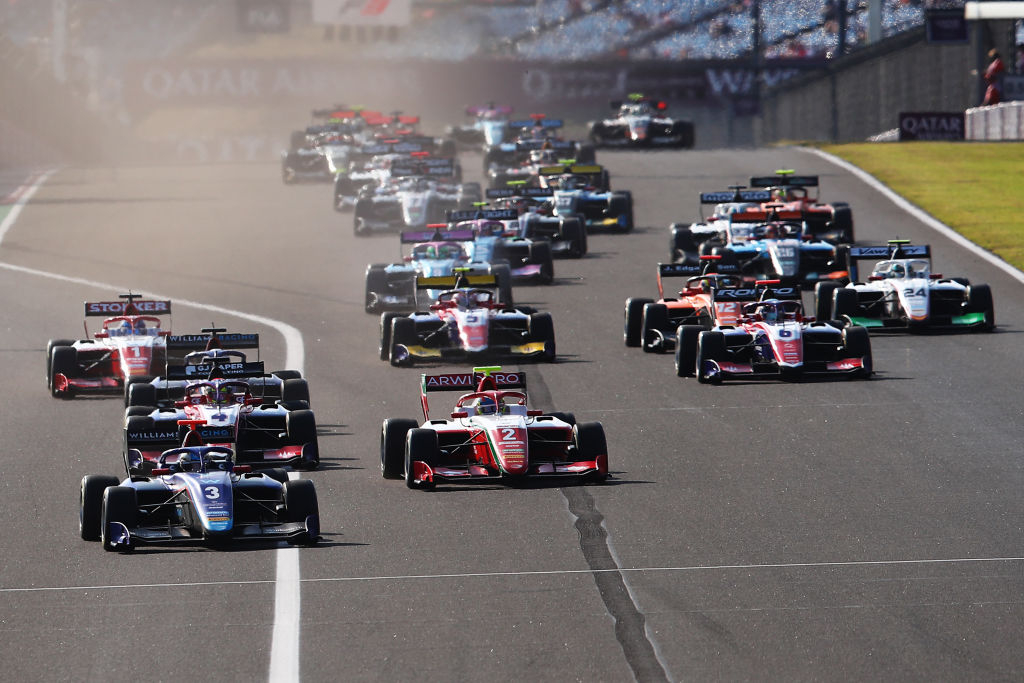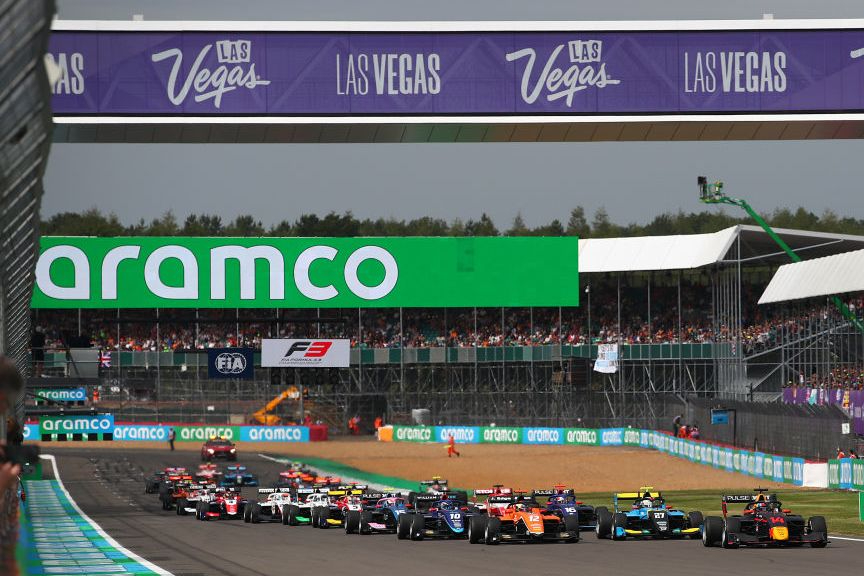
Photos: Formula Motorsport Ltd
“I truly think F3 should not be allowed 30 cars on track at one time at any point, even in dry conditions. I think it’s a matter of time before we have a big accident there, too.”
Those were the words of George Russell, director of the Grand Prix Drivers’ Association, last Thursday at a wet Spa-Francorchamps as Formula 1 and its support paddocks had safety at the forefront of their mind.
A few weeks earlier Formula Regional European Championship racer Dilano van’t Hoff had died in an accident at the track during low-visibility conditions, and F1 drivers were also unhappy with how much visibility-reducing spray they had to contend with while running on Pirelli’s wet-weather tyres. The race weekend looked wet, and the words of Mercedes-AMG driver Russell were significant given in his position he was effectively speaking on behalf of his fellow F1 drivers.
But his line on Formula 3 did cause a stir, and Formula Scout put it to many members of the support paddock to see what they thought about the safety and sustainibility of larger grid.
Friday (post-qualifying)
Gabriele Mini (Hitech GP), FIA F3 driver: “George, what he said about having less cars, there are some things that might be good, some things that might be a bit less good. To be honest, coming from Formula 4, there are many drivers that want to step up and having a smaller grid means that so many drivers would have less opportunities to step up. So this would mean that many maybe talented drivers could not reach their dream, or even try to reach their dream, because once they lose the year that they want to go [up], they maybe lose the money or for whatever reason they cannot step up.
“There are the pros, and also something that might be against. Of course it’s up to the FIA and directors to have this decision. We can only have our opinions on that. But in the end it’s not up to us to decide. I think we are surrounded by very competitive people and expert people, and know how to do for our safety and let us race the best, you know?”
 Pepe Marti (Campos Racing), FIA F3 driver: “The bigger the grid, the more opportunities people have. But at the same time, I think 40 cars on a race track are a lot of cars. But I mean, if GTs can manage in 24 hours with 50 cars, then I don’t think that should be an issue. As long as it’s safe, as long as you don’t have 40 cars on a track which is three kilometres in length, I think everything should be fine. So that’s up to the FIA as well. I think they’re doing a good job with that.
Pepe Marti (Campos Racing), FIA F3 driver: “The bigger the grid, the more opportunities people have. But at the same time, I think 40 cars on a race track are a lot of cars. But I mean, if GTs can manage in 24 hours with 50 cars, then I don’t think that should be an issue. As long as it’s safe, as long as you don’t have 40 cars on a track which is three kilometres in length, I think everything should be fine. So that’s up to the FIA as well. I think they’re doing a good job with that.
Saturday (post-sprint race)
Caio Collet (Van Amersfoort Racing), FIA F3 driver: “Yeah it’s obviously quite dangerous. Not only here, but I would say on smaller tracks. It’s a real mess, and it’s quite a big mess in qualifying and all this sort of stuff. But it’s just the way it is, and we just have to deal with it like people have been doing for the past five, six years.”
Taylor Barnard (Jenzer Motorsport), FIA F3 driver: “I don’t think in the last few years much has changed. The grid has stayed the same size. I think in qualifying, especially in the smaller tracks, it’s quite difficult to manage. Being at the back in the races, I think it’s quite sketchy with everyone going three-wide and these sorts of things on the first lap. Epeciually given these conditions we had today, I think it would have been sketchy. But I think it’s just the way it is, and we have to deal with it.”
Paul Aron (Prema), FIA F3 driver: “I think it’s a tricky question. Obviously the goal of the F3 and F2 championships is to prepare young drivers for F1. And the fact that there’s many cars adds more trickiness to it. But that’s part of developing as a driver. So it’s difficult to say. Obviously safety-wise, a lot of cars causes more dangerous situations, but at the same time as a young driver you need to learn how to manage traffic and how to get a clean lap in qualifying. In the races you need to manage taking risks, which is good things to learn at a young age.
“So it’s a difficult question, and in the end you want to give drivers as many opportunities as possible, and if you reduce the grid in F3 there’s less opportunities for drivers. So safety-wise, obviously less cars would help, but sporting-wise the more cars there is, the more chance there is for young drivers to drive in F3. So it’s difficult to say.”
 Hugh Barter (Campos Racing), FIA F3 driver: “I don’t think it’s too much of an issue to be fair. I mean look at FREC, it’s a bigger grid. I think it’s just in mixed conditions, these sort of [dangerous] things can happen. It’s very difficult to drive in tricky conditions. When you’re trying to gain positions, it can be tough and especially with the laps being so short or being cut down due to the medium compound. I think a lot of people wanna make up as many positions as quick as possible and it can cause a bit of desperate moves or, you know, trying to overpush. So I think that’s more the cause than anything.”
Hugh Barter (Campos Racing), FIA F3 driver: “I don’t think it’s too much of an issue to be fair. I mean look at FREC, it’s a bigger grid. I think it’s just in mixed conditions, these sort of [dangerous] things can happen. It’s very difficult to drive in tricky conditions. When you’re trying to gain positions, it can be tough and especially with the laps being so short or being cut down due to the medium compound. I think a lot of people wanna make up as many positions as quick as possible and it can cause a bit of desperate moves or, you know, trying to overpush. So I think that’s more the cause than anything.”
Luke Browning (Hitech GP), FIA F3 driver: “I don’t think [the grid is too big]. I think it’s up to the stewards and the FIA to decide if we’re safe to race or not. I trust their decision on it, to be honest. I think 30 cars is perfectly safe if managed correctly and 99% of the time it is. I’m happy with the size of the grid. I don’t struggle too much. I just think it’s just making the correct decision to race when the conditions are correct.
“It’s already expensive enough the ladder. You make less spaces available, the prices go up. It’s incredibly difficult to climb the ladder as it is and to make it more and more exclusive, it just makes it almost impossible for people coming from a normal background, which I’m sure George can sympathise with.”
Sunday (post-feature race)
Jack Doohan (Virtuosi Racing), Formula 2 driver: “A good question to answer. I don’t really have an issue with it. Feeder series, I think with that being all ways to F1, it’s a pyramid. So you have more cars, more teams, and it feathers out as you get closer and closer to the top. So I think what they try to do is give more people opportunity and young drivers to show their potential. And they’re doing that. Whether it’s too many, I don’t know. But it was never an issue for me.”
Nikita Bedrin (Jenzer Motorsport), FIA F3 driver: “I like it because there is a lot of fighting. I think 30 cars is just the limit, so the highest that should be on the grid. Because in F4, sometimes there are just under 50 cars and I think that’s too much, especially for qualifying. It becomes really difficult. Of course safety is important and the more cars are on track, the less safety you will have. So I’m quite happy with 30 cars and how big the cars are for me is also fine. I think it’s just on the limit.”